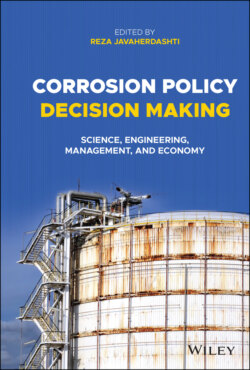Читать книгу Corrosion Policy Decision Making - Группа авторов - Страница 17
2.1.2.1 Standard Hydrogen Electrode/Electrochemical Series
ОглавлениеThe main assumptions that need to be made are as follows.
1 It is assumed that the reduction voltage for hydrogen reaction is zero. In other words, it is assumed that the conversion of hydrogen ion (H+) to hydrogen gas is zero. Needless to say that the actual voltage is not zero at all, but this assumption is accepted so that some chemical reactions can be placed above hydrogen evolution (due to their positive reduction voltage), and some reactions will be placed below that due to their negative potential. Those with positive potential will be noble, meaning that they are very highly likely to act as a cathode and those with negative potentials will be branded as active, meaning that they are very highly likely to act as an anode.
2 All of the substances taking part in the electrode reaction have unit activity.
3 Temperature is 25 °C.
4 Hydrogen pressure in the reference electrode is one atmosphere.Figure 2.2 Schematic presentation of electrochemical series with some reactions as cathodic and anodic reactions. Standard potentials (Eo) are in volts vs. SHE (standard hydrogen electrode).
Figure 2.2 schematically shows an example of an electrochemical series:
However, it is evident that items ii–iv can only be achieved under strict laboratory conditions and under real life, industrial conditions it is not possible to main temperatures and pressures as required by the electrochemical series. It can be said that it is mainly due to these restrictions as dictated by laboratory‐controlled conditions that industrial application of electrochemical series must be replaced with a more application‐friendly option. Although, as we see later, standard hydrogen potential is a necessary element in constructing Pourbaix diagrams, which are very useful in applications.
